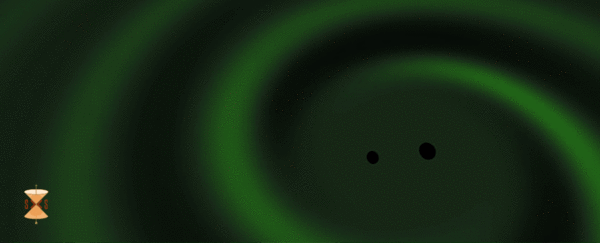When you strike a bell with a hammer, it rings for some time after, as the vibrating metal continues to resonate. And, as it turns out, when you strike a black hole with another black hole, something similar occurs - only instead of sound waves, the newly formed black hole sends gravitational waves rippling out across the Universe.
Those gravitational waves are like a chord, a jangle of notes. Encoded in these, according to Einstein's theory of general relativity, should be information about the black hole's mass and spin.
Now, in a brand new test of relativity, a team of astronomers has figured out how to tease out individual notes in the chord - or rather, frequencies in the gravitational waves - and, for the first time, have detected two of them - something that was thought impossible with our current technology.
You may be unsurprised to learn that, as per general relativity, they were able to measure the mass and spin of the black hole.
And they were also able to infer that these were the only detectable properties of the black hole - supporting the no-hair theorem that states that, also as per general relativity, black holes can only be characterised by mass and spin (all other properties being the "hair").
"We all expect general relativity to be correct, but this is the first time we have confirmed it in this way," said physicist Maximiliano Isi of MIT's Kavli Institute for Astrophysics and Space Research.
"This is the first experimental measurement that succeeds in directly testing the no-hair theorem. It doesn't mean black holes couldn't have hair. It means the picture of black holes with no hair lives for one more day."
The collision in question was the very first one ever detected, GW 150914, in September 2015. Scientists translated the gravitational waves into sound waves, producing a "chirp" signal; here's what that sounds like:
Just as the two black holes merge into one, there's a very brief period where the new black hole oscillates, sending out fainter gravitational waves. This is called the ringdown, and scientists had assumed that it would be too faint to detect or analyse after the gravitational wave peak at the moment of collision.
Previously, astrophysicist Matthew Giesler of Caltech and colleagues had determined, via simulations, that just after the gravitational wave peak, the ringdown period included a cacophony of "overtones" - loud, short-lived tones. By analysing a collision chirp in the context of overtones, the team could isolate a ringing "signature" of the new black hole.
Isi and his team took this work and applied it to GW 150914, focusing on the moment just after the peak of the chirp. And they were able to isolate the ringing signature - even down to identifying two distinct tones, corresponding to distinct vibrational frequencies from the new black hole.
"This was a very surprising result. The conventional wisdom was that by the time the remnant black hole had settled down so that any tones could be detected, the overtones would have decayed away almost completely," said theoretical astrophysicist Saul Teukolsky of Cornell University.
"Instead, it turns out that the overtones are detectable before the main tone becomes visible."
Einstein predicted that the pitch and decay of the tones in the ringdown of a black hole collision would be a direct product of the new black hole's mass and spin. The team was able to measure the pitch and decay of the two tones, which in turn allowed them to probe the properties of the black hole.
The mass and spin calculated from the pitch and decay of the tones matched previous measurements of these two properties - demonstrating that detecting the overtones of a black hole's ringdown can be accomplished today, with current methods - which means future technology could be even greater still.
"In the future, we'll have better detectors on Earth and in space, and will be able to see not just two, but tens of modes, and pin down their properties precisely," Isi said.
"If these are not black holes as Einstein predicts, if they are more exotic objects like wormholes or boson stars, they may not ring in the same way, and we'll have a chance of seeing them."
The research has been published in Physical Review Letters.
